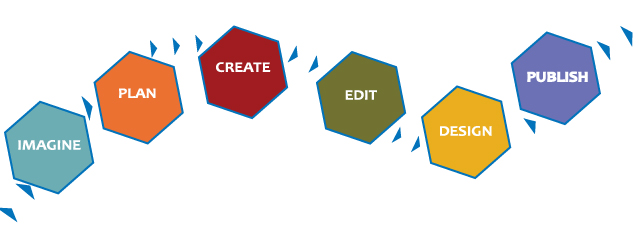The Writing Process: Your Book in Easy Stages
Biff Barnes
You’ve been thinking about creating a memoir or family history book. But you may feel a bit like you’re set off on a bit of an uncharted course. Creating a book seems like an overwhelming task. Looking at creating a book as a six-step process helps give you a roadmap which will make successfully seeing your book through to publication much less daunting.

STEP 1: IMAGINE
What belongs in the book? Generate as many stories as you can. Sort through your memories. Consult diaries or family documents. Your photographs may trigger stories. Interview relatives or friends who recall people or events you want to include. They may add interesting details to stories you know or even tell you stories you’ve never heard.
STEP 2: PLAN
Plan the order of your stories. Part of organizing is to decide what kind of book you want:
- A memoir which recalls the elements of your life that you find most interesting or important. You can pick and choose only the stories you want to tell.
- A family history is focused on the preservation and transmission of the family identity.
- A tribute book is written to express appreciation of a person’s positive influence on your life or to focus on their accomplishments.
- An ethical will is designed to provide a statement of the author’s accumulated values, beliefs and life lessons.
Then decide whether your stories can best be told chronologically or topically by focusing on topics like turning points, greatest accomplishments, or stages of life.
STEP 3: CREATE
Get your stories down on paper. Some people have found that literally recording their stories and having them transcribed is easier and captures their own unique storytelling voice better than writing. Others prefer to write their manuscript.
STEP 4: EDIT
Review your rough draft by looking at the big picture. Are there changes that will improve the book? You may find that you need to:
- Add more details to clarify or enhance a story.
- Cut material that is repetitious or doesn’t seem to fit.
- Move stories to create an order which flows better.
- Revise the way you told the story to clarify or heighten interest.
- Correct factual errors.
Don’t undertake this alone. Enlist a trusted friend or professional editor to help you revise.
STEP 5: DESIGN
This involves every aspect of how your book will look including cover photo, type font, page layout and photo placement. Again this is a step most authors entrust to a professional book designer.
STEP 6: PUBLISH
Choose a printer that fits your goals for the book. For example, do you seek limited distribution of an heirloom book to family and friends? Or do you want to sell the book and want a printing house that can help with marketing?
One thing that helps a lot of people stay on track is to set a date for when you want to see your book in print. Then work backwards for that date to determine when each of the steps must be completed. Deadlines can always be adjusted, but they also help make sure you are making progress toward your goal.